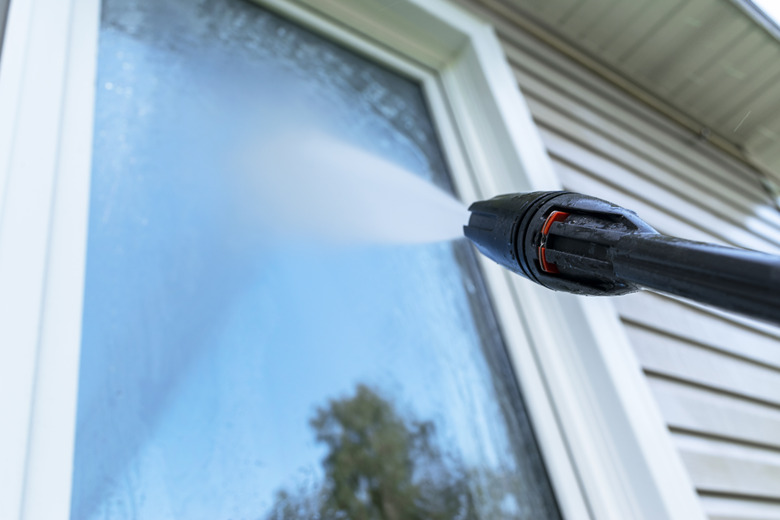Homemade Window Cleaners For Power Washers
We may receive a commission on purchases made from links.
Power washing windows makes a dirty job easy. Whether you choose a general or heavy-duty window cleaner, using a power washer allows you to reach second-story windows without resorting to ladders and/or scaffolding. After washing and rinsing, the windows will sparkle, but be aware that you'll now probably have to clean the siding and surrounding hardscape to bring it up to the same standard of cleanliness.
Cleaning Windows With a Power Washer
Cleaning Windows With a Power Washer
While a portable power washer may make the job of washing your windows easier, take a few precautions to avoid damaging your home or injuring yourself. Put on protective gear, including gloves, safety goggles, and shoes and set the nozzle at a low-pressure level per the manufacturer's directions. Keep the nozzle at least 3 feet away from the glass to prevent damage. Do not use a power washer while on a ladder; instead, use an extension wand or a second-story nozzle kit, which allows you to clean siding and windows that the standard nozzles cannot reach.
In addition, remove window screens and double-check to make sure all the windows are closed. Also check the glazing and caulking around wood-framed windows to make sure you don't accidentally damage the windows or push water under the siding.
If possible, wash windows on a cloudy day when the wind isn't blowing to prevent the soap solution from drying on the windows before you have time to rinse. Only wash a few windows at a time, working from the bottom up. Allow the solution to soak in for 10 to 15 minutes, rewetting as necessary. Rinse and then move on to the next set of windows.
Mixing Window Cleaner for a Power Washer
Mixing Window Cleaner for a Power Washer
Mixing your own power-washer window detergent requires a few household items, but do not use chlorine bleach, as it can damage the power washer. The simplest solution is 1 1/2 tablespoons of Dawn dishwashing liquid (or any other dishwashing liquid that contains sodium lauryl sulfate) mixed with 1 gallon of water. Add 2 cups of vinegar to the solution as needed to cut through years of accumulated grease and grime.
A quick-drying window-cleaning recipe requires mixing 1/2 cup of ammonia, 2 cups of rubbing alcohol, and 1 gallon of water. The ammonia cuts through the dirt, and the rubbing alcohol ensures quick drying but be sure to rinse the windows with water to remove any lingering dirt and grime.
You can also use equal parts of white vinegar or rubbing alcohol and warm water as a window-cleaning solution. Whichever solution you choose, pour it into the soap reservoir on the power washer. Be sure to open the shutoff valve and use the low-pressure nozzle when applying the window-washing solution.
Using Cleaners on Other Surfaces
Using Cleaners on Other Surfaces
Power washers are convenient for cleaning siding and concrete walks and driveways as well. When mixing a solution for vinyl siding, combine 1/3 cup each of trisodium phosphate and powdered laundry detergent with 1 gallon of hot water. Cover shrubs and vegetation around the house with tarps or plastic sheeting to protect the foliage. Work in stages, applying the soap solution from the bottom up with a low-pressure nozzle, pointing the tip downward to prevent water from infiltrating under the siding. Rinse with water from the top down.
To clean concrete surfaces, mix 1/2 cup each of borax and washing soda with 1 tablespoon of dishwashing liquid and 1 gallon of water. If a stronger solution is needed, double the first three ingredients and mix with 1 gallon of water. Stir everything together in a bucket and then pour it into the soap reservoir. Apply it with the low-pressure nozzle, allow it to soak into the concrete for 10 to 15 minutes, and then rinse with the high-pressure nozzle and plain water.
